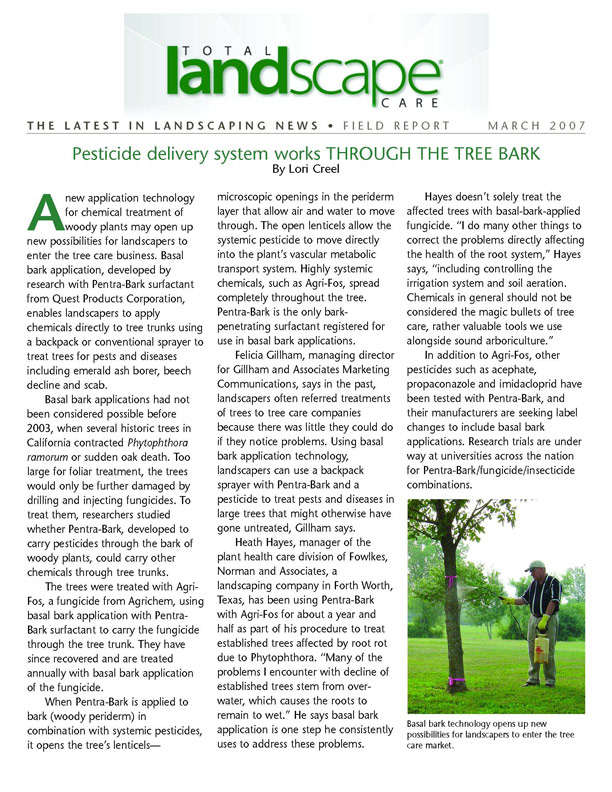Testimonials
From Total Landscape Care – March 2007 (see image below).
A new application technology for chemical treatment of woody plants may open up new possibilities for landscapers to enter the tree care business. Basal bark application, developed by research with Pentra-Bark surfactant from Quest Products Corporation, enables landscapers to apply chemicals directly to tree trunks using a backpack or conventional sprayer to treat trees for pests and diseases including emerald ash borer, beech decline and scab.
Basal bark applications had not been considered possible before 2003, when several historic trees in California contracted Phytophthora ramorum or sudden oak death. Too large for foliar treatment, the trees would only be further damaged by drilling and injecting fungicides. To treat them, researchers studied whether Pentra-Bark, developed to carry pesticides through the bark of woody plants, could carry other chemicals through tree trunks.
The trees were treated with Reliant, a fungicide from Agrichem, using basal bark application with Pentra-Bark surfactant to carry the fungicide through the tree trunk. They have since recovered and are treated annually with basal bark application of the fungicide.
When Pentra-Bark is applied to bark (woody periderm) in combination with systemic pesticides, it opens the tree’s lenticels-microscopic openings in the periderm layer that allow air and water to move through. The open lenticels allow the systemic pesticide to move directly into the plant’s vascular metabolic transport system. Highly systemic chemicals, such as Reliant, spread completely throughout the tree. Pentra-Bark is the only bark-penetrating surfactant registered for use in basal bark applications.
Felicia Gillham, managing director for Gillham and Associates Marketing Communications, says in the past, landscapers often referred treatments of trees to tree care companies because there was little they could do if they notice problems. Using basal bark application technology, landscapers can use a backpack sprayer with Pentra-Bark and a pesticide to treat pests and diseases in large trees that might otherwise have gone untreated, Gillham says.
Heath Hayes, manager of the plant health care division of Fowlkes, Norman and Associates, a landscaping company in Forth Worth, Texas, has been using Pentra-Bark with Reliant for about a year and half as part of his procedure to treat established trees affected by root rot due to Phytophthora. “Many of the problems I encounter with decline of established trees stem from over-water, which causes the roots to remain to wet.” He says basal bark application is one step he consistently uses to address these problems.
Hayes doesn’t solely treat the affected trees with basal-bark-applied fungicide. “I do many other things to correct the problems directly affecting the health of the root system,” Hayes says, “including controlling the irrigation system and soil aeration. Chemicals in general should not be considered the magic bullets of tree care, rather valuable tools we use alongside sound arboriculture.”
In addition to Reliant, other pesticides such as acephate, propaconazole and imidacloprid have been tested with Pentra-Bark, and their manufacturers are seeking label changes to include basal bark applications. Research trials are under way at universities across the nation for Pentra-Bark/fungicide/insecticide combinations.
By Lori Creel

